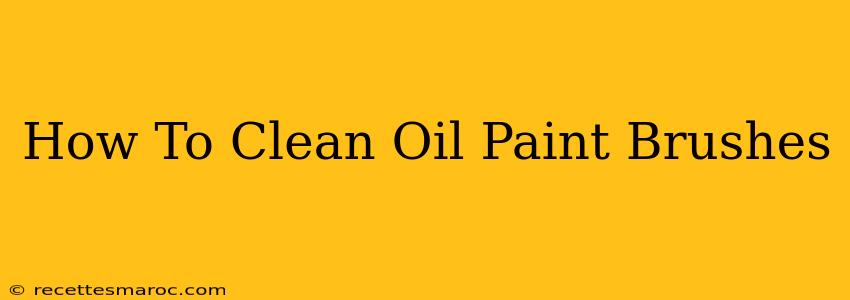Cleaning oil paint brushes might seem daunting, but with the right techniques and supplies, it's a manageable task that will significantly extend the life of your brushes. Neglecting proper cleaning will ruin your brushes, leading to hardened paint that makes them unusable. This guide will walk you through the process, ensuring your brushes remain soft, supple, and ready for your next masterpiece.
Essential Supplies for Cleaning Oil Paint Brushes
Before you begin, gather these essential supplies:
- Solvent: Mineral spirits (also known as white spirits) or odorless mineral spirits are the most common and effective solvents for oil paint. Turpentine can also be used but is generally considered harsher and more pungent.
- Brush Soap: A brush soap specifically designed for artists' brushes will help to remove lingering paint and condition the bristles. This is crucial after you've used the solvent.
- Containers: You'll need several containers: one for your solvent, one for rinsing, and one for soapy water. Old jars or disposable cups work well.
- Old Rags or Paper Towels: Lots of them! You'll need these to wipe the brushes clean.
- Optional: A Brush Comb: A brush comb helps to gently separate and reshape the bristles after cleaning.
Step-by-Step Guide to Cleaning Oil Paint Brushes
1. Immediate Cleaning is Key
The most important step is to clean your brushes immediately after painting. The longer the paint sits on the bristles, the harder it becomes to remove, making the cleaning process much more difficult.
2. Remove Excess Paint
Before using a solvent, wipe off as much excess paint as possible onto a rag or paper towel. This minimizes the amount of solvent needed.
3. Solvent Cleaning
- Submerge: Submerge the brush bristles into the container of mineral spirits or turpentine. Gently swirl the brush around to loosen the paint.
- Work the Paint Out: Use your fingers (wearing gloves is recommended) or a rag to work the paint out of the bristles. Pay attention to the ferrule (the metal part connecting the bristles to the handle), ensuring that no paint is accumulating there.
- Repeat: Repeat this process until the solvent runs clear, changing the solvent as needed.
4. Brush Soap and Rinsing
- Soap Up: Now, wash the brush thoroughly with brush soap and warm water. Gently work the soap into the bristles to remove any lingering solvent and paint residue.
- Rinse Thoroughly: Rinse the brush under running warm water, ensuring all traces of soap are removed. Continue rinsing until the water runs clear.
5. Reshaping and Drying
- Comb (Optional): Use a brush comb to gently separate and reshape the bristles.
- Reshape by Hand: If you don’t have a comb, gently reshape the brush with your fingers.
- Drying: Reshape the brush to its original form and lay it flat to dry. Avoid standing the brush upright, as this can cause the bristles to bend permanently.
Tips for Maintaining Your Oil Paint Brushes
- Clean Regularly: Don't wait until your brushes are heavily caked with paint. Regular cleaning is crucial for their longevity.
- Use the Right Solvent: Always use a solvent appropriate for oil paints.
- Store Properly: Store your clean brushes in a cool, dry place, away from direct sunlight.
FAQs
Q: Can I use water to clean oil paint brushes?
A: No, water will not dissolve oil paint. You must use a solvent like mineral spirits or turpentine.
Q: How often should I clean my oil paint brushes?
A: Ideally, you should clean your brushes after each painting session.
Q: What if the paint is completely dry on my brushes?
A: Soaking the brushes in solvent for a longer period might help, but severely hardened paint may be very difficult to remove. In this case, the brush may be beyond repair.
By following these steps and tips, you can ensure your oil paint brushes stay clean, in top condition, and ready to create stunning artwork for years to come. Happy painting!

